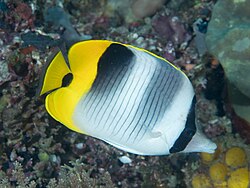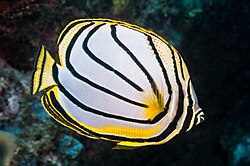| Species | Common name | Image |
|---|
| Aspilurochaetodon | Chaetodon gardineri Norman, 1939 | Gardner's butterflyfish |  |
| Chaetodon leucopleura Playfair, 1867 | Somali butterflyfish |  |
| Chaetodon selene Bleeker, 1853 | Yellow-dotted butterflyfish |  |
| Chaetodon adiergastos Seale, 1910 | Philippine butterflyfish, Panda butterflyfish |  |
| Chaetodon auriga Forsskål, 1775 | Threadfin butterflyfish |  |
| Chaetodon auripes D. S. Jordan & Snyder, 1901 | Oriental butterflyfish |  |
| Chaetodon collare Bloch, 1787 | Redtail butterflyfish, Pakistani butterflyfish |  |
| Chaetodon decussatus G. Cuvier, 1829 | Indian vagabond butterflyfish |  |
| Chaetodon ephippium G. Cuvier, 1831 | Saddle butterflyfish |  |
| Chaetodon falcula Bloch, 1795 | Blackwedged butterflyfish |  |
| Chaetodon fasciatus Forsskål, 1775 | Red Sea raccoon butterflyfish, diagonal butterflyfish |  |
| Chaetodon flavirostris Günther, 1874 | Black butterflyfish |  |
| Chaetodon lineolatus G. Cuvier, 1831 | Lined butterflyfish |  |
| Chaetodon lunula (Lacépède, 1802) | Raccoon butterflyfish, crescent-masked butterflyfish, lunule butterflyfish |  |
| Chaetodon melannotus Bloch & J. G. Schneider, 1801 | Blackback butterflyfish |  |
| Chaetodon mesoleucos Forsskål, 1775 | White-faced butterflyfish |  |
| Chaetodon nigropunctatus Sauvage, 1880 | Black-spotted butterflyfish |  |
| Chaetodon ocellicaudus G. Cuvier, 1831 | Spot-tail butterflyfish |  |
| Chaetodon oxycephalus Bleeker, 1853 | Spot-naped butterflyfish |  |
| Chaetodon pictus Forsskål, 1775 | Horseshoe butterflyfish | |
| Chaetodon rafflesii Anonymous [Bennett], 1830 | Latticed butterflyfish |  |
| Chaetodon semeion Bleeker, 1855 | Dotted butterflyfish |  |
| Chaetodon semilarvatus G. Cuvier, 1831 | Bluecheek butterflyfish |  |
| Chaetodon ulietensis G. Cuvier, 1831 | Pacific double-saddle butterflyfish, false falcula butterflyfish |  |
| Chaetodon vagabundus Linnaeus, 1758 | Vagabond butterflyfish |  |
| Chaetodon wiebeli Kaup, 1863 | Hong Kong butterflyfish |  |
| Chaetodon xanthocephalus E. T. Bennett, 1833 | Yellowhead butterflyfish |  |




















































































